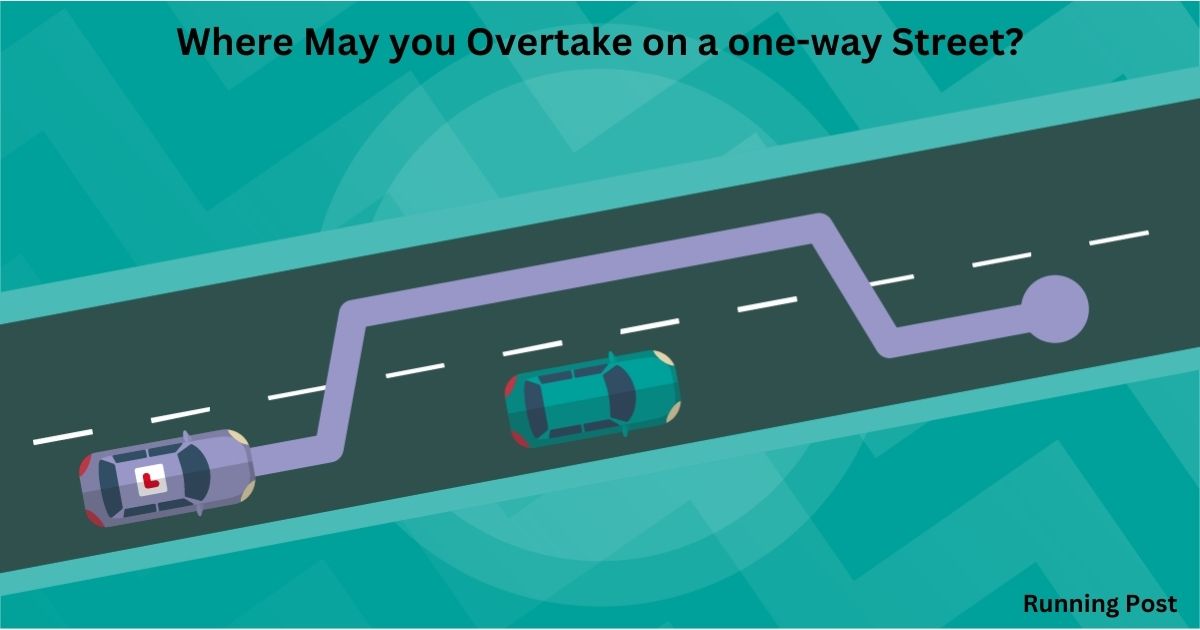A: Overtaking is not allowed on one-way streets
B: On either the right or the left
C: You can only overtake on the left side
D: Only on the left-hand side
Introduction
Understanding Overtaking Rules
Overtaking is a fundamental aspect of driving that requires a clear understanding of road rules and safety practices. It’s essential for ensuring smooth traffic flow and preventing accidents. Knowing when and where you can overtake not only helps you navigate the roads safely but also adheres to legal regulations designed to protect all road users.
In many countries, overtaking is governed by specific rules that vary depending on the type of road and traffic conditions. Understanding these rules is crucial for making safe and legal overtaking decisions. This is particularly important in complex situations, such as on one-way streets or multi-lane roads where the dynamics of traffic can change rapidly.
Importance of Knowing Where to Overtake
Knowing where to overtake is vital for both safety and efficiency. Proper overtaking helps in maintaining the flow of traffic and reduces the risk of collisions. On roads with multiple lanes or in specific scenarios like one-way streets, understanding where overtaking is permitted can help avoid dangerous maneuvers and potential accidents.
Adhering to overtaking rules also prevents legal issues. Driving without knowledge of where overtaking is allowed can lead to fines or penalties. It’s important for drivers to be aware of their surroundings and the specific regulations that apply to the roads they are on.
Overview of One-Way Streets
One-way streets are designed to facilitate smooth traffic flow by allowing vehicles to travel in only one direction. This design helps reduce congestion and the likelihood of head-on collisions. However, the rules for overtaking on one-way streets can differ from those on two-way streets.
In a one-way street, drivers may have more flexibility in terms of which side to overtake from, as there are no oncoming vehicles to consider. Despite this flexibility, it’s crucial to follow specific rules and guidelines to ensure overtaking is done safely and legally. Understanding these rules can make driving on one-way streets more efficient and less stressful.
General Rules for Overtaking

When May You Overtake?
Overtaking is permitted under certain conditions that prioritize safety and legality. Generally, you may overtake when the road is clear, and it’s safe to do so. Key conditions include:
- Visibility: Ensure that the road ahead is clear and you can see far enough to overtake safely.
- Speed Limits: Adhere to speed limits while overtaking to maintain control and avoid accidents.
- Road Markings: Follow road markings and signs that indicate whether overtaking is allowed.
Legal Conditions for Overtaking
Legal conditions for overtaking vary by jurisdiction, but common requirements include:
- No Overtaking Zones: Avoid overtaking in areas where road markings or signs explicitly prohibit it, such as curves, intersections, and pedestrian crossings.
- Safe Distance: Maintain a safe distance from the vehicle being overtaken and from oncoming traffic.
- Signaling: Use turn signals to indicate your intention to overtake, allowing other drivers to be aware of your maneuver.
Factors to Consider Before Overtaking
Before overtaking, consider the following factors to ensure safety:
- Road Conditions: Check for any potential hazards such as roadworks, potholes, or adverse weather conditions.
- Vehicle Performance: Ensure your vehicle is in good condition and has enough power to complete the overtaking maneuver safely.
- Traffic Flow: Assess the flow of traffic to avoid disrupting other vehicles or causing congestion.
Overtaking Locations on One-Way Streets
Where Should a Driver Overtake?
On one-way streets, drivers have the flexibility to overtake on either side, but there are best practices to follow:
- Right Side: Overtaking on the right side is generally preferred as it aligns with the direction of most traffic in countries where driving is on the right.
- Left Side: In some regions, overtaking on the left side might be common or required, depending on local traffic laws.
Best Practices for Safe Overtaking
To ensure safe overtaking on one-way streets:
- Check Mirrors: Regularly check your mirrors to monitor the positions of other vehicles.
- Signal Intentions: Use your turn signals to indicate your intention to overtake, allowing other drivers to anticipate your move.
- Maintain Speed: Keep a consistent speed to avoid sudden changes that could surprise other drivers.
Visual and Road Indicators
Be attentive to visual and road indicators that can affect overtaking:
- Road Signs: Look for signs indicating no overtaking zones or other restrictions.
- Road Markings: Follow road markings that guide overtaking and lane changes.
- Traffic Conditions: Pay attention to traffic flow and the behavior of other drivers to determine the best time to overtake.
Where May You Overtake on a One-Way Street?
On a one-way street, overtaking can be done:
- On Either the Right or the Left: Unlike two-way streets, one-way streets provide the flexibility to overtake from either side since there are no oncoming vehicles to consider. This allows for smoother traffic flow and easier navigation.
Avoiding Dangerous Overtaking Situations

Where Should You Avoid Overtaking?
Certain situations are particularly risky for overtaking:
- Curves and Hills: Avoid overtaking on curves or hills where visibility is limited.
- Intersections: Refrain from overtaking at or near intersections to prevent accidents.
- Pedestrian Crossings: Avoid overtaking near pedestrian crossings to ensure the safety of pedestrians.
Common Hazards and Obstructions
Be aware of common hazards that may make overtaking dangerous:
- Roadworks: Construction zones can create unexpected obstacles and reduce visibility.
- Parked Vehicles: Parked cars can obstruct your view and the path of overtaking.
- Weather Conditions: Adverse weather conditions like rain or fog can reduce visibility and road traction.
Situations Where Overtaking Is Not Advisable
In some situations, overtaking is not advisable:
- Heavy Traffic: Avoid overtaking in heavy traffic to prevent congestion and accidents.
- Narrow Roads: On narrow roads, overtaking may be difficult and unsafe due to limited space.
Special Considerations
When May a Driver Overtake?
Timing is crucial for safe overtaking:
- Clear Road Ahead: Overtake only when you have a clear and unobstructed view of the road ahead.
- Appropriate Speed: Ensure you are traveling at a speed that allows for safe overtaking without disrupting traffic.
Timing and Situational Awareness
Be aware of the following factors for effective timing:
- Traffic Flow: Assess the flow of traffic to choose the right moment for overtaking.
- Road Conditions: Consider road conditions that may affect the safety of overtaking.
Legal Requirements and Restrictions
Adhere to local legal requirements and restrictions:
- Local Laws: Follow specific overtaking laws and regulations in your region.
- Safety Standards: Ensure compliance with safety standards for overtaking, including signaling and maintaining a safe distance.
Where May a Driver Overtake on a 2 Plus 1 Road?
A 2 plus 1 road features two lanes in one direction and one lane in the opposite direction. Safe overtaking practices include:
- Designated Overtaking Zones: Use designated overtaking lanes where available.
- Single Lane Caution: Be cautious when overtaking in the single lane section, ensuring it’s clear and safe.
Explanation of 2 Plus 1 Roads
2 plus 1 roads are designed to balance traffic flow between high-capacity and low-capacity directions:
- Traffic Distribution: They allow for increased overtaking opportunities in the direction with two lanes.
- Lane Usage: Understand the lane usage and restrictions to safely navigate and overtake.
Safe Overtaking Practices on These Roads
Follow these practices for safe overtaking on 2 plus 1 roads:
- Use Designated Lanes: Use the designated overtaking lanes as indicated by road signs and markings.
- Check for Oncoming Traffic: Ensure there is no oncoming traffic in the single lane section before overtaking.
Conclusion
Summarizing Key Points
Understanding where you may overtake on a one-way street and other road types is crucial for safe driving. Key points include:
- Flexibility on One-Way Streets: You may overtake on either the right or left.
- Avoid Dangerous Situations: Steer clear of curves, intersections, and other risky areas.
- Follow Legal Requirements: Adhere to local laws and safety standards for overtaking.
Importance of Safe Overtaking
Safe overtaking practices are vital for preventing accidents and ensuring smooth traffic flow. By following the guidelines and understanding the rules, drivers can navigate roads more safely and efficiently.
Final Tips for Drivers
- Stay Alert: Always be aware of your surroundings and other road users.
- Follow Road Signs: Adhere to road signs and markings related to overtaking.
- Practice Patience: Sometimes waiting for a safer opportunity is the best choice for avoiding accidents.
You Also Like It:
willian da silva cavalcante willian da silva cavalcante 391.200.268/11
Releated Posts
MAB Instructor Certification: Your Gateway to Professional Crisis Management Leadership
In today’s fast-evolving professional environments—especially in healthcare, mental health, education, and corrections—conflict and aggression can arise without warning.…
Freewayget.com: Your Ultimate Platform for Deals, Discounts, and Digital Products
Introduction to Freewayget.com In today’s fast-paced digital world, finding reliable platforms that offer authentic discounts, deals, and digital…
Affordable & Fast Embroidery Digitizing Services in Your Area
Embroidery digitizing services provide corporations, designers, and people with brilliant embroidery-equipped designs by means of changing art work…
Introduction to hdhub4u nit
In this article, we will delve into the details of hdhub4u nit, exploring its features, benefits, and why…

















